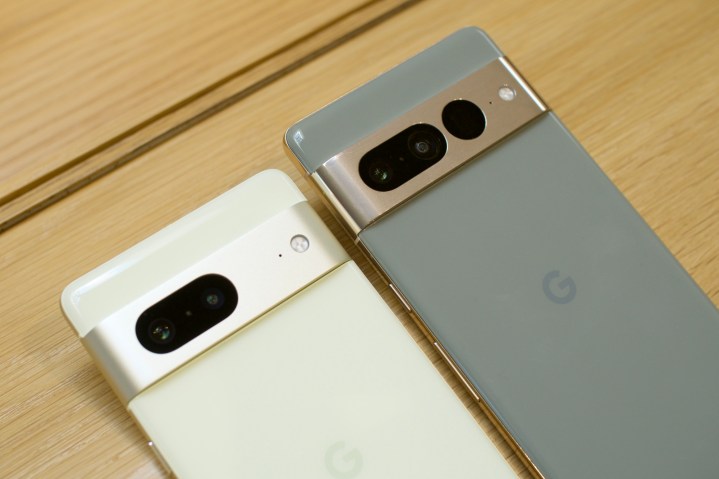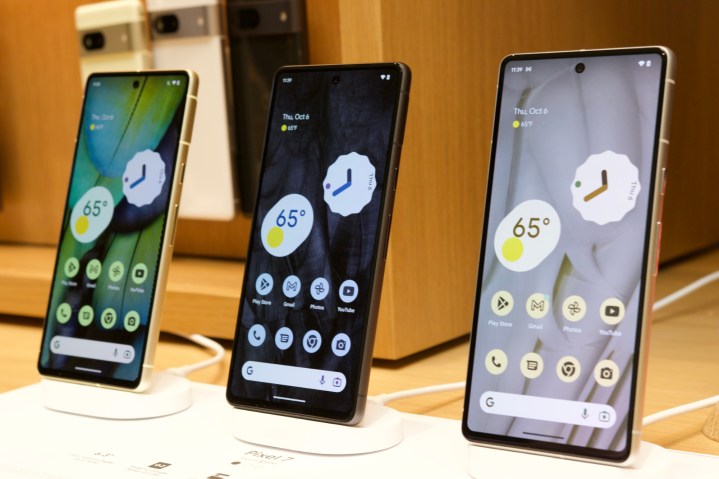With this month’s debut of the Pixel 7 and Pixel 7 Pro, it’s apparent Google has hit its stride. The company’s latest smartphones host a refined design language that builds on the recognizability and success of the Pixel 6 family while still expanding the features and capabilities of the platform.
While its new Tensor G2 processor has allowed Google to pack in a few surprises under the hood, the hardware design is almost entirely iterative, comprised of aesthetic changes to improve the look and feel of the Pixel 7 and Pixel 7 Pro without changing how you use your Pixel phone.

Is there a 3.5mm headphone jack in the Pixel 7?
It shouldn’t come as a surprise that Google hasn’t added a 3.5mm headphone jack to the Pixel 7 and Pixel 7 Pro. The last mainstream Pixel phone to include a wired analog headphone port was the original Pixel, released in 2016.
In an amusing turn of events, that first Pixel came on the heels of Apple’s iPhone 7, the first major smartphone to ditch the headphone jack entirely. A few weeks later, Google made hay of Apple’s controversial decision by pointing out that its new Pixel phone included a 3.5mm headphone jack that was “satisfyingly not new.” However, that didn’t stop Google from following suit a year later with the Pixel 2 — and every flagship Pixel released since.

For a long time, that wasn’t the case for Google’s more affordable A-series Pixel smartphones. The Pixel 3a, Pixel 4a, and Pixel 4a 5G all included the headphone jack, as did the Pixel 5a. However, in yet another ironic twist, Google roasted Apple again in a Pixel 5a promo video parodying the style of Jony Ive’s classic design montages, praising the beauty of the included circular headphone jack, only to subsequently exclude it from the Pixel 6a a few months later.
With that final move, it’s fair to say that Google is done with headphone jacks. The continuing inclusion of a wired audio port in Google’s a-series Pixel models was undoubtedly a concession to the more budget-friendly price of those phones. Those looking for an affordable smartphone weren’t likely to splurge on a pair of Google’s Pixel Buds Pro or other wireless headphones. However, Bluetooth headphones keep getting more affordable, and Google seemingly decided it was time to cut bait.
How do I use wired headphones with the Pixel 7?
It’s a relatively common (and somewhat cynical) take that both Apple and Google removed the headphone jack to push customers to buy their wireless earbuds. While the product timing is too coincidental to rule that out entirely — the first AirPods came out in 2016 alongside the iPhone 7, and Google released its first-generation Pixel Buds around the same time as the Pixel 2 — it’s not like wireless earbuds are the only option.
In fact, Pixel customers are better off today than ever and have a clear advantage over folks trying to use wired earbuds with an iPhone. Unlike Apple’s smartphones, the Pixel 7 and Pixel 7 Pro still include one important multipurpose port that’s based on an open standard.

We’re talking about the USB-C port, of course, which can handle charging, data transfer, and even audio. That’s not something Google and other smartphone makers have cooked up; Intel has already been pushing for USB-C to replace the headphone port for years. If anything, Google is late to the party.
There are two ways to use the Pixel 7’s USB-C port to deliver audio to a set of wired headphones. If you own a pair of USB-C headphones, you can plug them directly into the Pixel 7, and you should be good to go. However, in the more likely scenario that you still have a set of cans with a 3.5mm plug, you’ll need to pick up a USB-C headphone adapter. Google included these in the box with the Pixel 2 and Pixel 3 to help folks through the transition, but it’s long since stopped doing that, so you’ll need to supply your own.

It’s worth noting that USB-C can also offer a definitive quality advantage over a 3.5mm audio jack since it’s capable of outputting digital audio. In fact, it’s the only way you have any chance of listening to lossless audio from streaming music services that offer it. You’ll need to spend a bit more on a good digital-to-analog converter (DAC) to pull this off, but if you’re using a good set of headphones, the quality improvement could be well worth it.

